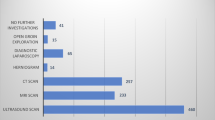Abstract
Background
Surgical treatment of inguinal hernias in adolescents is controversial as these patients do not fit into the traditional pediatric and adult populations. We aimed to compare the preferences of adult general surgeons and pediatric surgeons in managing adolescents by conducting a survey through social media.
Methods
A poll was posted on the International Hernia Collaboration Group Facebook page as well as the Facebook page for the authoring pediatric surgeon. The poll gave scenarios of a 16-year-old male with an inguinal hernia and asked surgeons to select one of five listed procedures to repair the hernia: high ligation (open or laparoscopic), mesh repair (open or laparoscopic) or open muscle repair. The four scenarios differed in the diameter of the internal ring (1 vs. 4 cm) and the BMI of the patient (20 vs. 35). Fisher’s exact test was implemented for statistical analysis.
Results
In total, 43 (67 %) adult surgeons and 21 (33 %) pediatric surgeons responded. In the routine adolescent (normal BMI, small defect), 65 % of adult surgeons chose adult-type repairs (mesh or muscle repairs) whereas 86 % of pediatric surgeons chose pediatric-type repairs (high ligation). When the size of the defect increased, 100 % of adult surgeons and 81 % of pediatric surgeons selected an adult-type repair, suggesting agreement. When the patient was obese, there was a tendency to prefer laparoscopy. In all patient scenarios, the answers were significantly different between pediatric and adult surgeons (p < 0.05).
Conclusion
For the same routine adolescent inguinal hernia, pediatric surgeons and adult general surgeons choose a different procedure. This finding suggests that further study is needed to determine the optimal treatment for inguinal hernias in adolescents, as the type of practitioner to whom the patient is referred, rather than the disease process itself, currently dictates treatment.
Similar content being viewed by others
References
Schumpelick V, Treutner KH, Arlt G (1994) Inguinal hernia repair in adults. Lancet 344:375–379
Kapur P, Caty MG, Glick PL (1998) Pediatric hernias and hydroceles. Pediatr Clin North Am 45:773–789
Koch A, Edwards A, Haapaniemi S, Nordin P, Kald A (2005) Prospective evaluation of 6895 groin hernia repairs in women. Br J Surg 92:1553–1558. doi:10.1002/bjs.5156
Alzahem A (2011) Laparoscopic versus open inguinal herniotomy in infants and children: a meta-analysis. Pediatr Surg Int 27:605–612. doi:10.1007/s00383-010-2840-x
Grosfeld JL, Minnick K, Shedd F, West KW, Rescorla FJ, Vane DW (1991) Inguinal hernia in children: factors affecting recurrence in 62 cases. J Pediatr Surg 26:283–287
Scott NW, McCormack K, Graham P, Go PM, Ross SJ, Grant AM (2002) Open mesh versus non-mesh for repair of femoral and inguinal hernia. Cochrane Database Syst Rev CD002197. doi:10.1002/14651858.CD002197
Bay-Nielsen M, Kehlet H, Strand L, Malmstrøm J, Andersen FH, Wara P, Juul P, Callesen T, Collaboration Danish Hernia Database (2001) Quality assessment of 26,304 herniorrhaphies in Denmark: a prospective nationwide study. Lancet 358:1124–1128. doi:10.1016/S0140-6736(01)06251-1
EU Hernia Trialists Collaboration (2002) Repair of groin hernia with synthetic mesh: meta-analysis of randomized controlled trials. Ann Surg 235:322–332
Author information
Authors and Affiliations
Corresponding author
Ethics declarations
Disclosures
Dr. Bruns, Dr. Glenn and Mr. McNinch have no conflicts of interest. Dr. Rosen is a speaker for Davol and Gore, has received research grants from Gore and Miromatrix and is a board member of Ariste Medical. Dr. Ponsky is an owner of GlobalCastMD.
Appendix
Appendix

Rights and permissions
About this article
Cite this article
Bruns, N.E., Glenn, I.C., McNinch, N.L. et al. Treatment of routine adolescent inguinal hernia vastly differs between pediatric surgeons and general surgeons. Surg Endosc 31, 912–916 (2017). https://doi.org/10.1007/s00464-016-5054-z
Received:
Accepted:
Published:
Issue Date:
DOI: https://doi.org/10.1007/s00464-016-5054-z




